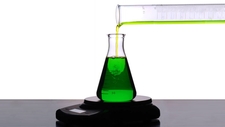Liquid Measures

TEKS Objective
The student is expected to collect, record, and analyze information using tools, including calculators, microscopes, cameras, computers, hand lenses, metric rulers, Celsius thermometers, prisms, mirrors, pan balances, triple beam balances, spring scales, graduated cylinders, beakers, hot plates, meter sticks, magnets, collecting nets, and notebooks; timing devices, including clocks and stopwatches; and materials to support observation of habitats of organisms such as terrariums and aquariums.
Essential Understanding
The student knows how to use a variety of tools, materials and methods to conduct science inquiry.
Science Background
Tools of Science for Elementary Science: BioEd Online (video) - This online presentation explains the importance of using the proper tools when conducting science investigations.
Tools of Science for Elementary Science
BioEd Online, www.bioedonline.org
Signature Lesson
Reading Graduated Cylinders and Beakers: Challenger Learning Center (PDF) - In this lesson, students make accurate measurements to collect, record, and analyze information using graduated cylinders and beakers.
Reading Graduated Cylinders and Beakers
Challenger Learning Center, www.challengerlearningcenter.com
- Supporting Lessons
- Extensions
- Assessment Ideas
- Literature Connections
- Related
TEKS - Additional Resources
Supporting Lessons
Applied Science, Science and Math Lab: MS Nucleus (website) - Students practice measuring liquids using graduated cylinders and beakers, with emphasis on how to interpret the meniscus.
Applied Science, Science and Math Lab
MS Nucleus, www.msnucleus.org
Measuring Lab: Utah Education Network (website) - This fun lesson illustrates the importance of using the proper tools (e.g., measuring cups and spoons, etc.) to measure ingredients for a recipe accurately.
Elaboration Lessons and Extensions
Density of Common Liquids: Learn NC (website) - Gauge the density of tap water and then compare it to the density of six other common liquids.
Assessment Ideas
Have students create their own measuring tools from unmarked water bottles. Using a graduated cylinder as the standard measure, students should pour specific quantities of water (e.g., 10 cl.) incrementally into the water bottle and mark a line next to each new level.
Literature Connections
Tools of the Ancient Romans. Dickinson, Rachel (ISBN-13: 978-0974934457)
Science Toolbox: Making and Using the Tools of Science. Stangl, Jean (ISBN-13: 978-0830643523)
Watch Out! Science Tools and Safety. Glass, Susan (ISBN-13: 978-1403483645)
Science Tools: Using Machines and Instruments. Davis, Jon (ISBN-13: 978-1404821996)
Additional Resources
Tools and Measurement: PBS (website) - Describes a variety of scientific tools and how to use them. Also includes activities and online resources related to the use of tools and measurement in science class.
Tools and Measurement
PBS, www.pbs.org
5th Grade Measurement and Data: K-5 Math Teaching Resources (website) - Conversion, representation and interpretation of measurements included
5th Grade Measurement and Data
K-5 Math Teaching Resources, www.k-5mathteachingresources.com
TEKS Navigation
Grade 5
Need Assistance?
If you need help or have a question please use the links below to help resolve your problem.

Comments